Bi-level Modelling For Linking Transport Activities With Location Choice In The Urban Area
Price
Free (open access)
Transaction
Volume
89
Pages
14
Published
2006
Size
527 kb
Paper DOI
10.2495/UT060511
Copyright
WIT Press
Author(s)
D. Parikesit
Abstract
Linking transport activities and location choice has been a subject of various researches. Recent works of Chang and Macket on bi-level modelling (BLM) and the mixed-spatially correlated logit (MSCL) model from Bhat and Guo have paved the way to develop a combination of both approaches in describing the two way relation between land use and transport. This paper examines further development of the approaches for two income levels and their implications on the transport demand estimation for the city of Yogyakarta, Indonesia. The result shows that the bi-level modelling is an appropriate approach to estimate the location choice and thus gives a better estimate of the travel demand to urban locations. The case study demonstrates that land value (in 10-4 Rp/m2) for the higher income group has a demand elasticity of -2.05 to the distance and the lower income group is -1.38. The research has indicated that the lower income group is affected by an inversed comparable-distance from the city centre. The equation can be used for policy makers to improve transport planning for the urban poor. Future works should be directed to provide theoretical and empirical foundation for disaggregated travel demand for lower income groups living in the urban core. Keywords: bi-level modelling, land use, transport impedance, income distribution, urban location. 1 Introduction Estimation and understanding of urban travel demand has been instrumental to develop proper policies and strategies in both regulatory frameworks and in the allocation of resources. The review of the World Bank [1] has identified that
Keywords
bi-level modelling, land use, transport impedance, income distribution, urban location.





